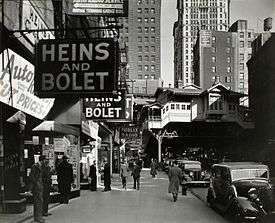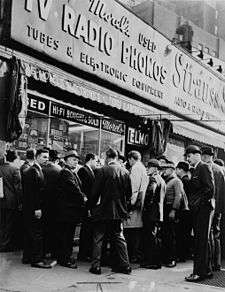Radio Row


Radio Row is a nickname for an urban street or district specializing in the sale of radio and electronic equipment and parts. Radio Rows arose in many cities with the 1920s rise of broadcasting and declined after middle of the 20th century.
New York City
Construction and existence
New York City's Radio Row, which existed from 1921 to 1966, was a warehouse district on the Lower West Side of Manhattan, New York City. Harry Schneck opened City Radio on Cortlandt Street in 1921, creating Radio Row. Radio Row was torn down in 1966 to make room for the World Trade Center.[1] It held several blocks of electronics stores, with Cortlandt Street as its central axis. The used radios, war surplus electronics (e.g., ARC-5 radios), junk, and parts often piled so high they would spill out onto the street, attracting collectors and scroungers. According to a business writer, it also was the origin of the electronic component distribution business.[2]
The New York Times made an early reference to "Radio Row" in 1927, when Cortlandt Street celebrated a "Radio Jubilee". The Times reported that "Today... Cortlandt Street is 'Radio Row,' while Broadway is just a thoroughfare." The street was closed and decorated with flags and bunting, and the Times reported plans for New York's acting mayor Joseph V. McKee to present a "key to Cortland Street" to the then-reigning Miss New York, Frieda Louise Mierse, while a contest was held to name a "Miss Downtown Radio."[3]
Meyer Berger recalled that, as a child, "On Saturday mornings, I used to venture from Brooklyn with my father to Radio Row on Cortlandt Street in Lower Manhattan, where he and hundreds of other New York men moved from stall to stall in search of the elusive tube that would make the radio work again. Later, my brothers went there with him in search of television components. Radio Row was a piece of all our interior maps."[4]
In 1930, the Times described Radio Row as located on Greenwich Street "where Cortlandt Street intersects it and the Ninth Avenue Elevated forms a canopy over the roadway.... The largest concentration is in the block bounded by Dey Street on the north and Cortlandt on the south, but Radio Row does not stop there; it overflows around the corner, around several corners, embracing in all some five crowded blocks." It estimated 40 or 50 stores in the vicinity, "all going full blast at the same time. There may be regulations prohibiting this vociferous practice, but if the radio dealers have anything to say it about it, it will never have the slightest effect along Radio Row.... The clamor is heard even as one walks through the subway tunnel to the street exit.... The first impression, and in fact the only one, is auditory, a reverberating bedlam, a confusion of sounds which only an army of loudspeakers could produce." It noted, in addition to merchants selling radio sets, "others display mostly accessories... one shopkeeper last week featured a crystal set small enough to fit into a pocket, and another gave prominent position to a bucket of condensers about an inch in side."[5]
World War II was unkind to Radio Row, and in 1944 the Times lamented that the "one-time repository of nearly everything from a tube socket to a complete radio station" was "bargainless and practically setless, too, due to wartime scarcities" but that it still catered to "tinkerers and engineers" and that an "old spirit" and "magical quality" were still there. One shop said it was practically able to stay in business just by "making repairs on the electric meters burned out by the students of the city schools who were studying radio," and all were optimistic about growing public interest in "two new kinds of radio: FM and television."[6] Radio Row rebounded.
Demolition
Plans for the use of eminent domain to remove the shops in the area bounded by Vesey, Church, Liberty, and West streets began in 1961 when the Port Authority of New York and New Jersey was deciding between the east side of Lower Manhattan and the west side near the Hudson and Manhattan Railroad terminals.[7]
After the decision was made to raze the streets on the west side for the World Trade Center, local opposition emerged. Sam Slate reported on this for WCBS Radio in 1962:
Shaping up in New York City is a legal battle of overriding importance. Its outcome will conceivably affect us all. If the considerable power of the Port Authority is allowed to dispossess the merchants of Radio Row, then, it is our conviction, no home or business is safe from the caprice of government.[8]
The city also objected to the compensation given for the streets themselves obscured by the superblock.
Oscar Nadel headed the committee of small business owners opposing the condemnation proceedings. He estimated that 30,000 people worked in businesses generating $300 million per year. The Port Authority offered $3,000 to each business as compensation regardless of the size or length of time it had been located in the area.[9] The court case was titled Courtesy Sandwich Shop v. Port of New York Authority and the final appeal was lost by the small business owners in November 1963 "for want of a substantial federal question".[10]
After the closing of these stores, the concentration of radio retailers was not duplicated elsewhere in New York. Some clusters of radio and electronics stores were created or added to in the Canal Street and Union Square areas.
A large black-and-white photo mural of Radio Row can be viewed at the World Trade Center Port Authority Trans-Hudson station.
Major firms that started on New York's Radio Row include Arrow Electronics, Avnet, and Schweber Electronics.
Boston
In 1923, The Boston Globe reported that a section of the North End had been dubbed "Radio Row" because of the large number of radio antennas being installed in that neighborhood. "The hurdy-gurdy has a rival," wrote the Globe, and "No skyline anywhere else in the city or the suburbs is filled with so many antennae as the blocks stretching along some sections of Hanover and Salem sts. Many residents have three or four aerials—one has six—with wires leading down to receiving sets of all descriptions, in the homes of the foreign-born residents. It has all come about in a few months.... All stairways lead to the roof, where [some residents] are arranging to rig up a loudspeaker, connected with instruments below. A survey of housetops... shows a whole population getting ready."[11]
Modern day versions in Asia
In the second half of the 20th century and early 21st century, a shift in electronics manufacturing to Asia led to the formation of similar electronics districts in cities with significant electronics industries.
Alternate meaning
Radio Row may also refer to a large grouping of sports talk radio stations that broadcast from the Super Bowl media center during the week before the annual major football game.[12]
See also
- Tin Pan Alley
- Business cluster
- Electronic waste
- In London, UK, until the early 1980s there were shops selling surplus electronics on Tottenham Court Road, Edgware Road and Lisle Street.
- Akihabara, Tokyo, Japan
- Yongsan Electronics Market, Seoul, Korea
- Guang Hua Digital Plaza, Taipei, Taiwan
- Pudu Market, Kuala Lumpur
- Khlong Thom Market, Bangkok
- Apliu Street, New Kowloon, Hong Kong
References
- ↑ "'Radio Row:' The neighborhood before the World Trade Center". National Public Radio. 2002-06-03. Retrieved 2006-10-01.
- ↑ Hartman, Amir (2004). Ruthless Execution: What Business Leaders Do When Their Companies Hit the Wall. Financial Times Prentice Hall. ISBN 0-13-101884-1., p. 167 "The electronic component distribution business started in the 1920s and 1930s, selling radio tubes on lower Manhattan's Cortland [sic] St...."
- ↑ "'Radio Row' Begins Its Jubilee Today," The New York Times, September 6, 1927, p. 34
- ↑ Berger, Meyer (2004). Meyer Berger's New York. Fordham University Press. ISBN 0-8232-2328-0. p. 11
- ↑ "Bedlam on Radio Row: Downtown Mart Continues its Musical Pandemonium, But Meantime Sells Cameras and Golf Balls." The New York Times, May 25, 1930, p. 144
- ↑ Kennedy, T. R., Jr., "Cortlandt Street," The New York Times, November 19, 1944, p. X7
- ↑ Glanz, James; Eric Lipton (2003). City in the Sky: The Rise and Fall of the World Trade Center. Times Books. p. 56. ISBN 0-8050-7428-7.
- ↑ Glanz, op. cit. p.62
- ↑ Glanz, op. cit. p.68
- ↑ Glanz, op. cit. p.87
- ↑ Cullinan, Howell (1923), The Boston Globe, May 6, 1923, p. A5.
- ↑ Schonbrun, Zach (2014), "Before Big Game, Stepping Into Media’s Big Top on Radio Row." The New York Times, January 29, 2014. http://www.nytimes.com/2014/01/30/sports/football/before-big-game-stepping-into-medias-big-top.html?_r=0
Further reading
- Gabrielan, Randall. New York City's Financial District in Vintage Postcards. Arcadia Publishing. ISBN 0-7385-0068-2.
External links
- Program on NPR about radio row
- Vintage postcard showing Radio Row
- "What was Radio Row like before the World Trade Center". PBS: The American Experience.
- The Death of Surplus
- Apex Electronics, Your Souce for Oscilloscopes and Drop Tanks
- The History of "Radio Row," NYC's First Electronics District
Coordinates: 40°42′39.4″N 74°0′45.5″W / 40.710944°N 74.012639°W